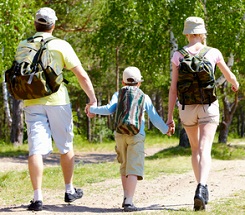The “Anywhere” Nature Walk
- April 5, 2012
- By Christy Peterson
 “Just get kids outside” has been the theme of recent news stories, health campaigns, and scientific studies. Mounting evidence suggests that interacting with nature benefits children in numerous ways, including improved concentration, cognitive development, and creativity.
“Just get kids outside” has been the theme of recent news stories, health campaigns, and scientific studies. Mounting evidence suggests that interacting with nature benefits children in numerous ways, including improved concentration, cognitive development, and creativity.
Sadly, I think this evidence gets added to the “things to feel guilty about” list. As parents, we know what we’re supposed to be doing—the real trick is finding time to achieve it. The world is a different place than when we were children. Lazy days of wandering the neighborhood and exploring the back forty seem to be artifacts of the past. We may wish it weren’t so, but what can one person do against a cascade of reasons to stay inside?
I’m sure you can tell by the title of the article where this conversation is headed. What I want to emphasize, though, is that encountering nature in all its amazing forms is not as difficult as it may seem. It does not require acres of land or even a backyard. It does not require special equipment, only your own senses. It does not require expertise, only a sense of wonder.
So, round up the kids, don your coats and hats (or whatever clothing is appropriate for the day), and head outside (after you finish the article, of course)!
Where to Go?
If this seems like a foolish question, perhaps you live in a rural area and can just head out across the fields. Not everyone is so fortunate. If you live in an apartment or in an urban area, just figuring out where to go can be a challenge.
In some ways though, an urban nature walk demonstrates better than anything how tenacious life is. Nature really is everywhere, and no one says your walk has to occur in vast, open spaces. A patch of moss, a weedy lot, or a plaza full of pigeons will do nicely. Even a dandelion growing through a crack in the concrete is a candidate for closer examination. If the concrete jungle seems omnipresent, you can turn your walk into a nature scavenger hunt!
What to Bring?
Don’t leave home without water and a snack. If your children enjoy writing about or drawing what they observe, you can throw some colored pencils and paper into the pack. Magnifying glasses are fun. Binoculars are nice, but not necessary. A bag (or two!) for treasures is a must! I always carry adhesive bandages. In short, bring items you think might make the outing more enjoyable, but not so many things that you wear yourself out carrying it all!
Using the Senses to Observe the World
When you arrive at your chosen spot (you can also practice these techniques at stops along the way), ask the kids to close their eyes and focus on what they hear. Pose the following questions, with time to listen in between:
*What are the loudest sounds you hear?
*What sounds are quietest?
*Which are natural sounds and which a human-caused?
Encourage the kids to keep their eyes closed for a little longer and focus on the next sense—smell.
*What do you smell?
*Does it smell pleasant? stinky?
*Are the smells strong or just barely noticeable?
Now you can have the children open their eyes and focus on what they see.
*What do they notice right away?
*What do they see that is human-made?
*What do they see that is natural?
*Do they see any animals? (Look closely—bugs are animals too!)
This is a good time to break out the sketch books and magnifying glasses. As they write about or draw what they observe, have the kids pay attention to the last sense—touch.
*What feels smooth, bumpy, soft, hard, etc.
You’ll notice we left out one sense—taste. Nature is best left untasted, and this leads us to the last topic:
A Word about Safety
I believe children learn best when they can interact with the world around them, with all their senses. That said, common sense dictates that there are appropriate ways for this interaction to occur. Here are the rules we follow in our household:
*Don’t put your hands and feet anywhere you can’t see into or over.
*Don’t pick and eat any plants, berries, or mushrooms.
*Don’t handle any wild creature without permission. If you are given permission, handle it respectfully and gently.
*Learn about poisonous animals and plants in your area and how to avoid negative contact.
The Last Word
I understand the struggle to get kids outside because even as I write this article, my own kids are probably playing video games or watching TV! But one ant, dandelion, or pigeon at a time, they are encountering the natural world. Your children can too—just get outside!